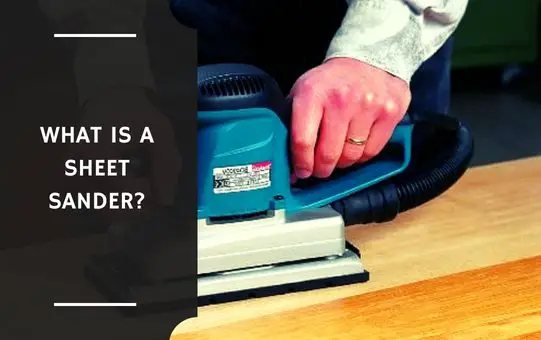Do you ever feel frustrated trying to sand a surface by hand? Are you looking for a tool that can help you achieve a smooth, even surface in no time?
If so, a sheet sander might be the perfect solution for you. This powerful tool is designed to make sanding large surfaces easier and more efficient.
What Is a Sheet Sander?
A sheet sander is a type of power tool that uses a vibratory motion to sand surfaces. It is most commonly used for sanding flat surfaces such as those found on wooden furniture or drywall.
A sheet sander is similar to a hand-held orbital sander, but it is larger and has a flat sanding surface.
The sheet sander is designed to move in a circular motion around the surface, sanding off the top layer of material.
Keep reading to learn more about sheet sanders and how they can help you get the job done faster.
See Also: What is a sheet sander used for?
What is a Sheet Sander? – Guide
A sheet sander, also known as a finishing sander, is a handheld power tool used for sanding and smoothing wood, metal, plastic, and other materials.
The tool is equipped with a vibrating sandpaper sheet that is fastened to a flat rectangular base, making it easy to access and sand even the hardest-to-reach surfaces.
Types
There are two main types of sheet sanders: orbital sanders and random orbital sanders. Orbital sanders have a small, circular sanding pad that oscillates in a small, circular motion.
This type of sander is best suited for removing paint, smoothing rough surfaces, and preparing surfaces for refinishing.
Random orbital sanders, on the other hand, have a sanding pad that rotates in a circular motion and orbits around the center of the tool.
This type of sander is ideal for sanding and finishing, as it leaves a smoother surface than an orbital sander and reduces the risk of sanding marks or swirls.
Features of Sheet Sanders
- Power source: Sheet sanders can be powered by electricity or batteries, depending on the model. Electric sanders tend to have more power, making them better suited for heavy-duty sanding tasks, while battery-powered sanders are more portable and convenient for on-the-go sanding.
- Dust collection: Many sheet sanders come equipped with dust collection systems that help to keep your work area clean and dust-free. This feature is particularly useful for those working with wood, as it helps to keep sawdust from clogging up the sandpaper and the sander’s motor.
- Variable speed control: Some sheet sanders have variable speed control, allowing you to adjust the speed of the sander to match the task at hand. This feature is particularly useful for sanding delicate surfaces, where a slow speed is needed to prevent damage.
- Sandpaper attachment: Sheet sanders come with various sandpaper attachment options, including hook-and-loop systems, which make it easy to change the sandpaper when needed.
Benefits of Using a Sheet Sander
- Speed: Sheet sanders are much faster than sanding by hand, saving you time and effort.
- Consistency: Sheet sanders provide consistent results, making it easier to achieve a smooth and even surface.
- Versatility: Sheet sanders are versatile power tools that can be used for various sanding tasks, such as removing old paint, smoothing rough surfaces, and preparing surfaces for staining or painting. They can be used on various materials, such as wood, metal, and plastic, and come in different shapes and sizes to fit into tight spaces or sand large areas quickly.
How to Use a Sheet Sander?
When using a sheet sander, it is important to take safety precautions such as wearing protective gear, such as eye and hearing protection, and following the manufacturer’s instructions.
- Choose the right sandpaper: When sanding, it is important to choose the right sandpaper grit. Coarse sandpapers, such as those with a grit of 60 or 80, are best for removing rough or rough spots. Finer sandpapers, such as those with a grit of 120 or 150, are best for sanding and smoothing surfaces.
- Attach the sandpaper: Attach the sandpaper to the sander’s base, making sure that it is securely fastened.
- Adjust the speed: If your sander has a variable speed control, adjust the speed to match the task at hand.
- Begin sanding: Begin sanding by holding the sander with both hands and applying light pressure. Move the sander in a back-and-forth motion, making sure to overlap each pass.
- Change the sandpaper: When the sandpaper becomes clogged or worn, change it for a fresh sheet.
Conclusion
A sheet sander is a tool that can be used for a variety of tasks, from smoothing rough edges to polishing surfaces.
It’s a great option for both professionals and DIYers alike, as its versatile nature and ease of use make it a great tool for any project.
With its versatility and power, a sheet sander is an invaluable tool for anyone wanting to achieve professional results.
Whether you’re a professional or a DIY enthusiast, it’s a great tool to have in your toolbox. I hope this blog post is helpful for you in understanding what is a sheet sander.
Read Also: Are sheet sanders any good?
